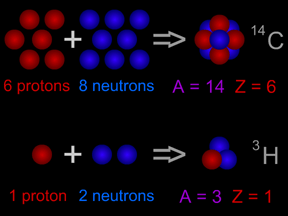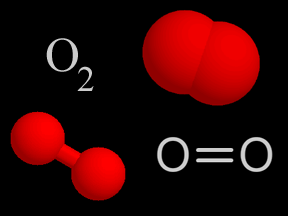Shown here are four representations chemists use for molecular oxygen. In colored molecular models, oxygen is traditionally shown in red.
Click on image for full size
Windows to the Universe original artwork by Randy Russell.
Oxygen
Oxygen is a chemical element with an atomic number of 8 (it has eight protons in its nucleus). Oxygen forms a chemical compound (O2) of two atoms which is a colorless gas at normal temperatures and pressures.
Oxygen is very reactive, so oxygen atoms are incorporated into many common chemical compounds, such as water (H2O), carbon dioxide (CO2), carbon monoxide (CO), sulfur oxides (SO2 and SO3), and nitrogen oxides (NO and NO2).
About 20% of Earth's atmosphere is oxygen. This hasn't always been the case, though. Early in our planet's history, the atmosphere had almost no oxygen. Microbes that produce their food via photosynthesis generate oxygen as a byproduct. Oxygen from photosynthetic microbes eventually built up in the atmosphere, drastically changing our planet's environment and the history of life in the process.
Oxygen plays a critical role in respiration, the energy-producing chemistry that drives the metabolisms of most living things. We humans, along with many other creatures, need oxygen in the air we breath to stay alive. Oxygen is generated during photosynthesis by plants and many types of microbes.
Oxygen can also form a molecule of three atoms, which is known as ozone (O3). Ozone in Earth's stratosphere plays a helpful role by blocking most of the harmful UV radiation from the Sun, while ozone in the troposphere is a hazardous pollutant.
You might also be interested in:

The atomic number of an atom tells us how many protons are in the nucleus of that atom. Why is that important? The chemical properties of an element are determined by the number of electrons in its atoms,
...more
Using a surprisingly simple, inexpensive technique, chemists have found a way to pull pure oxygen from water using relatively small amounts of electricity, common chemicals and a room-temperature glass
...more
Have you ever seen the Southern or Northern Lights? Did you know that Earth isn't the only planet that puts on these beautiful light shows, also known as the "aurora"? Auroral displays have also been observed
...more
Most things around us are made of groups of atoms bonded together into packages called molecules. The atoms in a molecule are held together because they share or exchange electrons. Molecules are made
...more
About 90% of the ozone in the Earth's atmosphere lies in the region called the stratosphere which is found between 16 and 48 kilometers (10 and 30 miles) above the Earth's surface. Ozone forms a kind of
...more
Less than 1% of the gases in Earth's atmosphere are called greenhouse gases. Even though they are not very abundant, these greenhouse gases have a major effect. Carbon dioxide (CO2), water vapor (H2O),
...more
The Ozone Hole. The Ozone Hoax. Pollution. Skin Cancer. The topic of ozone makes headlines on a regular basis, but why does a single molecule merit such media coverage? How important is the ozone in our
...more















